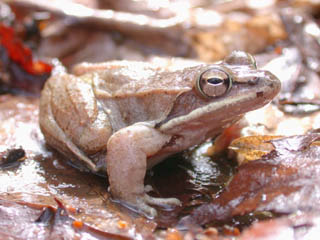Wood Frog
From Wikipedia, the free encyclopedia
[Photo] Rana sylvatica. From http://www.pwrc.usgs.gov/armiatlas/species.cfm?recordID=173440
Wood Frog is the common name given to Lithobates sylvaticus, previously Rana sylvatica. They are the only frogs found north of the Arctic Circle. In winter, as much as 35-45% of the frog's body may freeze, and turn to ice. Ice crystals form beneath the skin and become interspersed among the body's skeletal muscles. During the freeze the frog's breathing, blood flow, and heart beat cease. Freezing is made possible by specialized proteins, glucose and perhaps accumulation of urea, which prevent intracellular freezing and dehydration. Individual Wood Frogs tend to stay in the same 1,000 square foot (100 m²) area during their lifetime.
Physical description
Wood Frogs range from 35 to 76 millimeters (roughly 1.5 to 3.0 inches) in length. The females are much larger than males. They are usually brown, tan, and rust colored. The underparts of the frogs are yellowish and sometimes greenish-white.
Diet
Wood Frogs eat a variety of insects and other small invertebrates, especially spiders, beetles, moth larvae, slugs and snails. The tadpoles consume algae.
Habitat
Wood Frogs are found from northern Georgia and in isolated colonies in the central highlands in the eastern to central parts of Alabama, up through the northeastern United States, and all the way across Canada into Alaska. It is the most widely distributed frog in Alaska. They can be found from southeastern Alaska to north of the Brooks Range.
Wood Frogs primarily breed in ephemeral pools rather than permanent water bodies such as ponds or lakes. Adults emerge from hibernation in early spring and migrate to nearby pools. There, males chorus (a quacking sound) and mating occurs. Eggs are deposited in masses that float on the surface, often aggregated with those of other females in rafts. Larvae quickly develop and emerge in early to mid summer. If pools dry up before larvae have completed metamophosis, larvae are stranded and reproductive effort is lost. Thus, hydroperiod (length of time pools holds water) is of utmost importance for individual reproductive success of Wood Frog adults. Following successful metamorphosis, juveniles travel to neighboring moist woodlands. A small percentage will disperse and breed in other pools, but the majority are philopatric, returning to natal pools to breed.
Adult Wood Frogs spend summer months in moist woodlands, forested swamps, and bogs where they forage and maintain body moisture as surrounding evironments dry out. Females' eggs are formed by late fall. By late fall or early winter, they leave forested swamps and travel to neighboring uplands to overwinter. Some may remain in moist areas to overwinter. Hibernacula tend to be in the upper organic layers of the soil, under leaf litter, and in close proximity to breeding pools.
Wood Frogs have complex life cycles, requiring multiple habitats throughout their life history stages. Thus, their habitat conservation is complex, requiring landscape-scale connectivity. In this, they are no different than most ranids; habitat destruction including road building, wetland loss and degradation are primary causes for amphibian declines globally.
http://en.wikipedia.org/wiki/Wood_Frog
| The text in this page is based on the copyrighted Wikipedia article shown in above URL. It is used under the GNU Free Documentation License. You may redistribute it, verbatim or modified, providing that you comply with the terms of the GFDL. |
|

